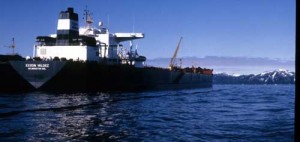A Conversation with Bob Nicholas and Jason Theriot
On March 24, 1989, the U.S. oil industry encountered a day of reckoning. Just after midnight, the Exxon Valdez supertanker carrying Alaskan crude to California ran aground on Bligh Reef in Prince William Sound, Alaska, spilling nearly eleven million gallons of oil into one of the nation’s most beautiful coastal habitats. At the time, this was the largest oil spill in history in American waters.
Although it occurred thousands of miles away from Houston, this disaster had strong connections to our region. Exxon USA, headquartered in downtown Houston, was the Exxon subsidiary responsible for the Exxon Valdez. In the days just after the spill, numerous Exxon USA employees were summoned to Alaska to join the company’s effort to get the spill under control.
On the morning after the spill, Bob Nicholas, a Port Arthur, Texas, native and General Counsel for Exxon Shipping Company, received an urgent telephone call at his Houston home. Within hours, he and a crew of Exxon representatives flew to Valdez, Alaska, to respond to this disaster. Before the end of the day, he was on board the Exxon Valdez, which was still aground on Bligh Reef.
In the wake of the Valdez tragedy, Congress passed its most stringent oil pollution legislation of the twentieth century: the Oil Pollution Act of 1990 (OPA-90). In this issue of the Houston History Magazine, Mr. Nicholas, who has practiced maritime law in Houston for nearly 30 years, shares his personal experience in this historic event and discusses the impact of the OPA 90 legislation on the Houston Ship Channel and Galveston Bay.
Jason Theriot: What was your immediate reaction to the telephone call that you received on March 24, 1989?
Bob Nicholas: I remember I was about to leave my house. It was Good Friday. It was a holiday, and I was on my way down to my sailboat. I was just packing stuff in the car, and my wife came out and said, “There is a phone call from Captain Bill Duncan.”. . . The first thing I heard was that the Exxon Valdez had run aground in Prince William Sound and that I needed to get to Intercontinental Airport to meet at the Exxon terminal as soon as possible. That’s where the group was gathering there to fly up to Valdez.
It was kind of funny—I remembered one of the things I packed was a suit, anticipating that I might have to go to some kind of Coast Guard hearing. Everything I did was based upon the routine that I had been doing for many years in responding to a marine casualty. As it turned out, though, the reality and the magnitude of Valdez was totally different. It was a completely different experience from anything I had ever had been involved with in connection with a marine casualty. This was brought about because of the huge media blitz and the large amount of oil that was spilled. This was a major environmental event and not just another ship casualty.
To read the complete article, download the pdf version.


 Follow
Follow